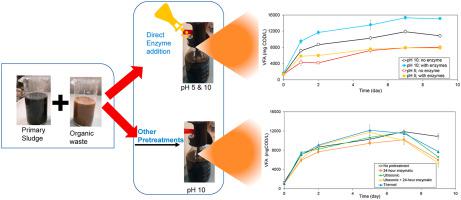Biomass & Bioenergy ( IF 6 ) Pub Date : 2021-01-09 , DOI: 10.1016/j.biombioe.2020.105950 Isaac Owusu-Agyeman , Srija Balachandran , Elzbieta Plaza , Zeynep Cetecioglu

|
The effects of direct enzyme cocktail addition and other pretreatment methods on VFA production through co-fermentation of primary sludge and external organic waste were studied under initial alkaline (pH 10) and acidic (pH 5) conditions. Besides the direct enzymes addition, 24-h enzymatic, ultrasonic, ultrasonic+24-h enzymatic and thermal were the other pretreatment methods employed. Under the alkaline condition, direct addition of enzymes enhanced VFA production by 29–39%, attaining VFA yields of 364–633 mg COD g−1 VS throughout the experimental period, whereas there was 37–43% increase in VFA production under the acidic condition only at retention days 1 and 2, achieving VFA yield of 207 and 215 mg COD g−1 VS, respectively. VFA composition was dominated by acetic acid (54–67%) and propionic acid (31–46%) under alkaline and acidic conditions, respectively. Direct enzyme addition increased the percentage of caproic acid from 8-9% to 16–17%, under the acidic condition. While 24-h enzymatic pretreatment didn't show any improvement on VFA production, thermal, ultrasonic+24-h enzymatic and ultrasonic pretreatment methods increased VFA production by only 18, 14 and 4%, reaching maximum VFA yields of 512, 486 and 445 mg COD g−1 VS, respectively. On the other hand, these pretreatment methods significantly increased biogas production. Experiment without pretreatment achieved maximum biogas production of 392 NmL CH4 at day 9 while experiments with pretreatments achieved a maximum of 679–954 NmL CH4 in the order of no pretreatment < ultrasonic < thermal < 24-h enzymatic < ultrasonic+24-h enzymatic. The study gives insight into how pretreatment strategy can influence VFA production and composition.
中文翻译:

市政废物流的共同发酵:预处理方法对挥发性脂肪酸产生的影响
在初始碱性(pH 10)和酸性(pH 5)条件下,研究了直接添加酶混合物和其他预处理方法对初生污泥和外部有机废物共同发酵对VFA产生的影响。除了直接添加酶外,还采用了其他的预处理方法,包括24小时酶促,超声波,超声+24小时酶促和热解。在碱性条件下,直接添加酶可使VFA产量提高29–39%,在整个实验期间,VFA产量达到364–633 mg COD g -1 VS,而在酸性条件下,VFA产量增加37–43%仅在保留第1天和第2天才恢复原状,VFA产量分别为207和215 mg COD g -1VS,分别。在碱性和酸性条件下,VFA的成分分别为乙酸(54-67%)和丙酸(31-46%)。在酸性条件下,直接添加酶使己酸的百分比从8-9%增加到16-17%。尽管24小时酶促预处理对VFA的生产没有任何改善,但热,超声+24小时酶促和超声预处理方法仅将VFA的产量提高了18%,14%和4%,最大VFA产量达到512、486和445 mg COD g -1 VS分别。另一方面,这些预处理方法显着增加了沼气的产生。在不进行预处理的情况下,最大沼气产生量为392 NmL CH 4在第9天,而采用预处理的实验则达到了最多679-954 NmL CH 4,其顺序为不进行预处理<超声波<热<24小时酶促<超声波+24小时酶促。该研究深入了解了预处理策略如何影响VFA的产生和组成。



























 京公网安备 11010802027423号
京公网安备 11010802027423号